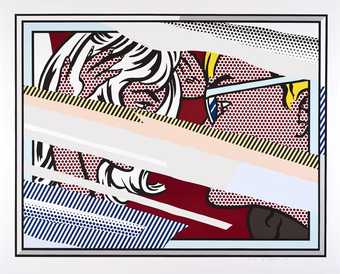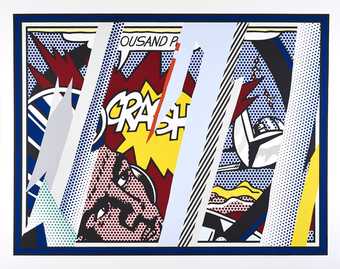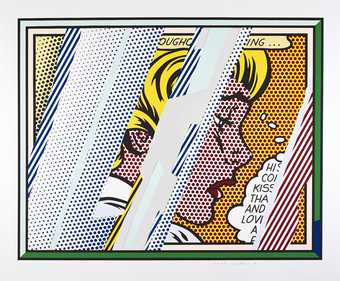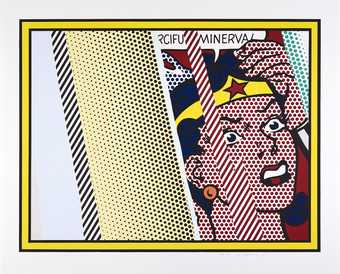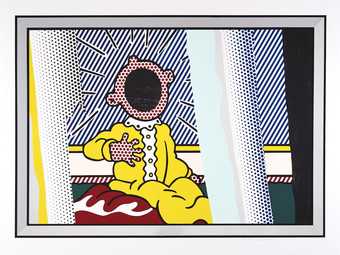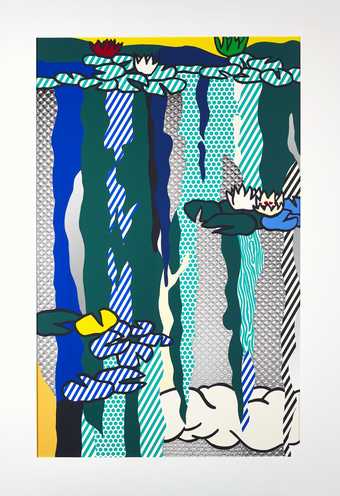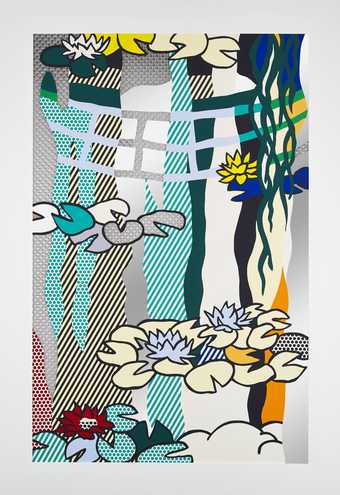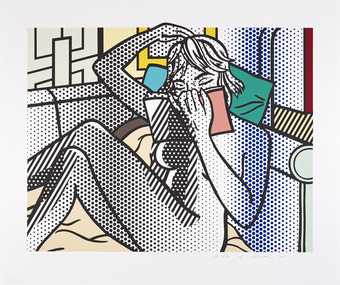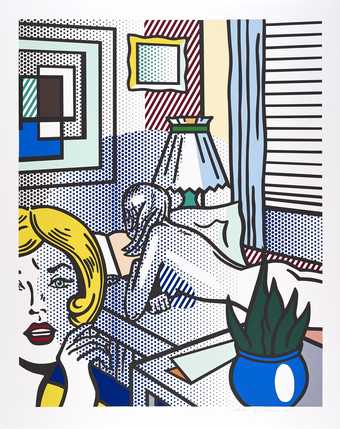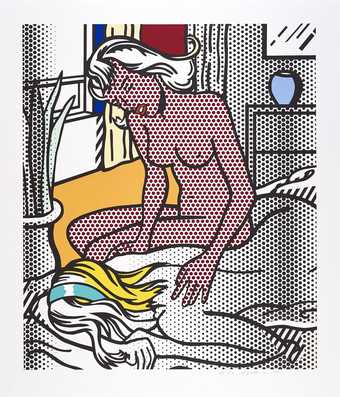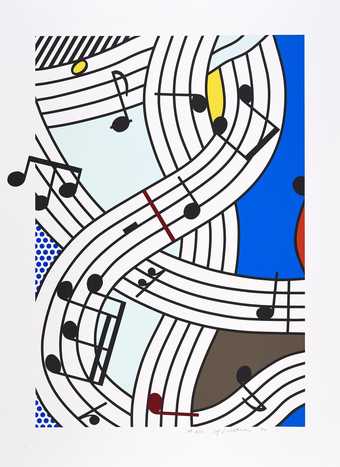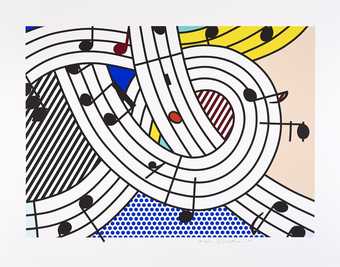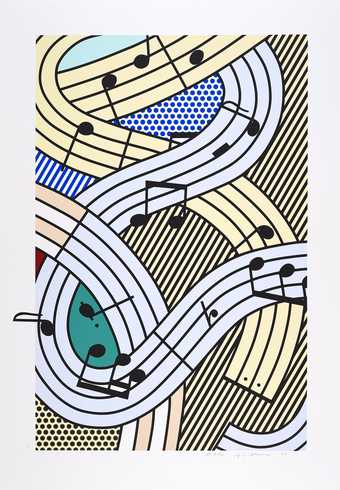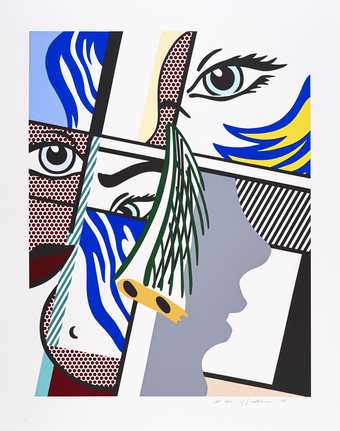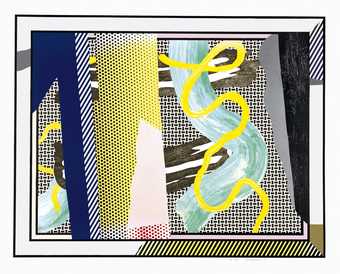
Not on display
- Artist
- Roy Lichtenstein 1923–1997
- Medium
- Screenprint on enamel on stainless steel
- Dimensions
- 1473 × 2146 mm
- Collection
- ARTIST ROOMS
Tate and National Galleries of Scotland. Lent by The Roy Lichtenstein Foundation Collection 2015
On long term loan - Reference
- AL00374
Summary
Water Lily Pond with Reflections 1992 is one of a series of six screenprints on stainless steel that Lichtenstein made on the subject of water lilies, a series which pays homage to Claude Monet’s (1840–1926) ‘Nymphéas’ paintings of water lilies (see, for example, Water Lilies after 1916 [Tate L01903]). Two others from the series are also in Tate’s collection: Water Lilies with Japanese Bridge 1992 (Tate AL00373) and Water Lilies with Cloud 1992 (Tate AL00372). Lichtenstein collaborated with Donald Saff at Saff Tech Arts in Oxford, Maryland to produce the prints. Tate’s copies are from the set of artist’s proofs aside from the edition of twenty-three, and are recorded in the catalogue raisonné of the artist’s prints (Corlett 1994, pp.241–2). These works are a highly accomplished and innovative form of printmaking on stainless steel, and involved the development of a new technique in order to achieve a particular pattern on the metal. As Mary Lee Corlett noted in the catalogue raisonné:
the swirl patterns in the metal dashboards that Lichtenstein remembered from the automobiles of the 1920s and 1930s had been a longtime interest of his, but one that had not found expression until the Saff Tech Arts project. At Saff Tech, a method was developed to create the swirls, using a drill press fitted with a rubber end and suspended upside down from the ceiling. Production of the pattern was labour intensive, as each swirl was executed individually. Sign painter’s enamel was screenprinted on the metal to build a surface of colour that is collage-like in appearance. Lichtenstein designed all of the original frames. Although not apparent in photographs, the images transmogrify – reflecting the light and colour of the room they occupy, shifting and changing as the prints are viewed from different angles.
(Corlett 1994, p.239.)
Lichtenstein made numerous paintings and prints based on the work of other artists, including Pablo Picasso and Henri Matisse, and had first made works that paid homage to Monet in 1969, with a series of prints after the French painter’s Cathedral and Haystack series (see Tate P07407–P07413). However, the Water Lilies series can also be related to Lichtenstein’s preoccupation with reflections, the roots of which can be found in his early pop art works, and which he developed throughout his career, most notably in the Mirror paintings made between 1969 and 1972 and which continued in the Reflection series of paintings and prints in the early 1990s (see the series of Reflections prints [Tate P12127, P12128 and AL00367–AL00371]).
Lichtenstein was born in New York, and was a central player in American pop art. He came to prominence in the 1960s, making works based on imagery from comic strips, such as In the Car and Whaam! 1963 (Tate T00897). In these works he used the Benday dot, common to newspaper and magazine reproduction, to produce works that appeared mechanically reproduced, and which in fact are even more stylised than the cartoons Lichtenstein appropriated. Printmaking was an integral part of his practice throughout his career from the late 1950s through to the 1990s.
Further reading
Mary Lee Corlett, The Prints of Roy Lichtenstein: A Catalogue Raisonné: 1948–1993, New York and Washington D.C. 1994.
Mary Lee Corlett and Ruth E. Fine, The Prints of Roy Lichtenstein: A Catalogue Raisonné: 1948–1997, New York and Washington D.C., revised and updated second edition 2002.
Graham Bader (ed.), OCTOBER Files 7: Roy Lichtenstein, Cambridge, Massachusetts and London 2009.
James Rondeau and Sheena Wagstaff, Roy Lichtenstein: A Retrospective, exhibition catalogue, Tate Modern, London and Art Institute of Chicago 2012.
Lucy Askew
Senior Curator, Scottish National Gallery of Modern Art, Edinburgh
August 2014
Amended by Stephen Huyton
Assistant Collection Registrar, ARTIST ROOMS
September 2017
Does this text contain inaccurate information or language that you feel we should improve or change? We would like to hear from you.
Explore
- abstraction(8,615)
-
- from recognisable sources(3,634)
-
- landscape(1,191)
- formal qualities(12,454)
-
- Ben-Day dots(32)
- cartoon / comic strip(177)
You might like
-
Roy Lichtenstein Reflections on Conversation
1990 -
Roy Lichtenstein Reflections on Crash
1990 -
Roy Lichtenstein Reflections on Girl
1990 -
Roy Lichtenstein Reflections on Minerva
1990 -
Roy Lichtenstein Reflections on The Scream
1990 -
Roy Lichtenstein Water Lilies with Cloud
1992 -
Roy Lichtenstein Water Lilies with Japanese Bridge
1992 -
Roy Lichtenstein Nude Reading
1994 -
Roy Lichtenstein Roommates
1994 -
Roy Lichtenstein Two Nudes
1994 -
Roy Lichtenstein Composition I
1996 -
Roy Lichtenstein Composition II
1996 -
Roy Lichtenstein Composition III
1996 -
Roy Lichtenstein Modern Art II
1996 -
Roy Lichtenstein Reflections on Brushstrokes
1990

